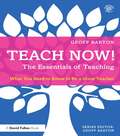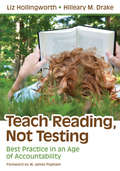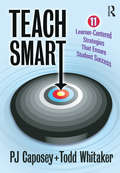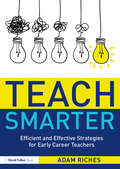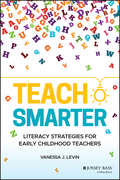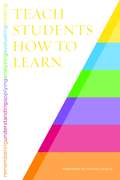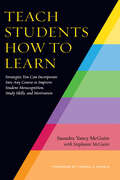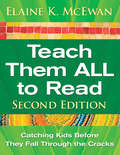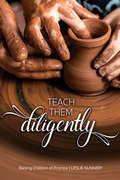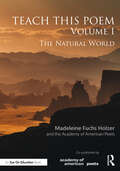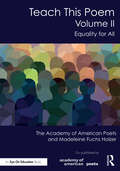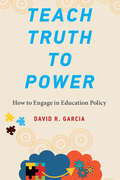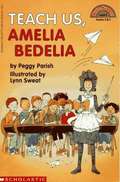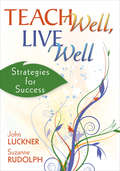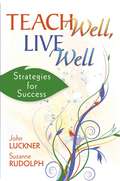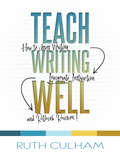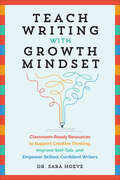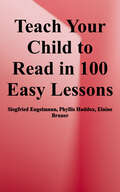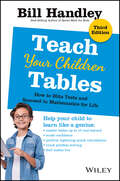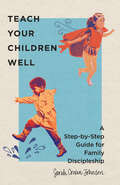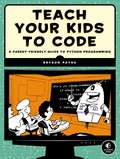- Table View
- List View
Teach Now! The Essentials of Teaching: What You Need to Know to Be a Great Teacher (Teach Now!)
by Geoff BartonBeing taught by a great teacher is one of the great privileges of life. Teach Now! is an exciting new series that opens up the secrets of great teachers and, step-by-step, helps trainees to build the skills and confidence they need to become first-rate classroom practitioners. Teach Now! The Essentials of Teaching provides the fundamental knowledge for becoming a great teacher. Combining a grounded, modern rationale for learning and teaching with highly practical training approaches it covers everything you need to know from preparing for your teaching practice to getting your first job. Harnessing a range of simple, but powerful techniques, the book shows you how you can translate the Teachers’ Standards into your own classroom practice and provide the evidence that you have met them. It also demystifies what the best teachers know and do instinctively to create students who want to learn and get a buzz from developing new skills. The book is structured in clear sections which are then divided into short, easy-to-absorb units offering clear, straightforward advice on all aspects of teaching including: why teach? the application and recruitment process for training helping students’ achieve good progress planning, differentiation and assessment behaviour management using language effectively in the classroom managing parents’ evenings being an effective tutor how to have lunch! With talking points to encourage reflection and a wide range of examples to illustrate practice, Teach Now! The Essentials of Teaching provides expert guidance as you start your exciting and rewarding career as an outstanding teacher.
Teach Reading with Orton-Gillingham: 65 Classroom-Ready Lessons to Help Struggling Readers and Students with Dyslexia Learn to Love Reading
by Kristina Smith Heather MacLeod-VidalGive young readers the tools they need to improve reading fluency and master letter-sound relationships with this teacher-friendly book of multisensory lessons based on the proven Orton-Gillingham (OG) reading approach. Bringing Orton-Gillingham and multisensory teaching into your classroom has never been easier. With this big book of easy-to-follow lesson plans, you can help your struggling students or those with dyslexia start reading today. Teach Reading with Orton-Gillingham offers research-based suggestions and instructions to make reading multisensory and engaging. Whether it&’s using sand or shaving cream, there are tons of fun, proven ideas and strategies to help your students better understand key concepts like letter-sound relationships. With 9 unique units and 72 different lesson plans, each unit will include lessons, tips, pictures, reference charts, suggested teaching timelines, and more resources. Also included are strategies for customizing this approach, whether you&’re working one-on-one, within small groups, or in a whole-class setting.
Teach Reading with Orton-Gillingham: A Companion Guide with Dictation Activities, Decodable Passages, and Other Supplemental Materials for Struggling Readers and Students with Dyslexia
by Kristina Smith Heather MacLeod-VidalA Simon & Schuster eBook. Simon & Schuster has a great book for every reader.
Teach Reading, Not Testing: Best Practice in an Age of Accountability
by Professor Liz Hollingworth Hilleary M. DrakeTeaching IS rocket science—and you are the pilot! The authors reinforce what teachers already know—test preparation worksheets and drill-and-kill activities do not make children into lifelong readers. This book’s conscientious approach to reading instruction combines an insider perspective on the development of high-stakes tests with classroom experience in achieving successful reading outcomes at the elementary and secondary levels. Their research-based methodology is based on five key components: Aligning instruction to the state or national core standards Using formative assessment Connecting units to real-world contexts Motivating students effectively Holding on to best practice in literacy instruction
Teach Smart: 11 Learner-Centered Strategies That Ensure Student Success
by Todd Whitaker P J CaposeyTransform your classroom from teacher-centered to learner-centered! This book shows you how with eleven easy-to-implement strategies you can use immediately to put students at the center! Get your students geared up for success and high achievement with great ideas for providing a roadmap; giving the work back; differentiating daily instruction; communicating for your audience, not to your audience; giving students choices; planning intentional engagement; asking better questions, and so much more! For each strategy, you get a clear example of what it looks like in action, as well as a breakdown of how to make it work in your classroom!
Teach Smarter: Efficient and Effective Strategies for Early Career Teachers
by Adam RichesAs a teacher, the more efficient you are, the less stressful work becomes, and the more effective you are, the more you can focus on teaching those in front of you. Teach Smarter is an essential guide that helps early career teachers reduce their unnecessary workload by offering practical classroom strategies that can save you, and those you work with, time. With a focus on keeping teaching simple and ensuring everything has a meaningful purpose, this book offers guidance on reducing workload through careful reflection and evaluation of your teaching practice. Offering ways to adjust your pedagogy and streamline your approaches in the classroom, Teach Smarter gives you more time to focus on what is important: helping your students progress. Questioning what it means to "teach smart", the chapters explore topics including: Planning Feedback Classroom space Expectations Reflecting on your teaching and managing stress Written by an experienced classroom teacher, coach and mentor, this book is essential reading for trainee teachers, NQTs and RQTs.
Teach Smarter: Literacy Strategies for Early Childhood Teachers
by Vanessa J. LevinDiscover new, practical methods for teaching literacy skills in your early childhood classroom. Has teaching early literacy skills become a stumbling block to getting your preschool students kindergarten ready? Break out of the tired “letter of the week” routine and learn how to transform your lessons with fun and effective techniques. Teach Smarter: Literacy Strategies for Early Childhood Teachers will equip teachers to infuse every aspect of their teaching with exciting hands-on literacy teaching methods that engage students and help them build authentic connections with books, so that 100% of their students will have a strong literacy foundation and will be fully prepared for success in kindergarten and beyond. Respected author Vanessa Levin, veteran early childhood educator and author of the “Pre-K Pages” blog, breaks down the research and translates it into realistic, actionable steps you can take to improve your teaching. Features specific examples of teaching techniques and activities that engage students in hands-on, experiential learning during circle time, centers, and small groups. Offers a simple, four-step system for teaching literacy skills, based on the foundational principles of early literacy teaching Demonstrates how to build your confidence in your ability to get 100% of your students ready for kindergarten, long before the end of the school year Understand the problems with traditional literacy teaching and identify gaps in your current teaching practice with this valuable resource.
Teach Students How to Learn: Strategies You Can Incorporate Into Any Course to Improve Student Metacognition, Study Skills, and Motivation
by Saundra Yancy McGuire Stephanie McGuireThe learning strategies and the psychological insights about learning presented in this book will be useful for teachers of students of all ages, including parents of young children.
Teach Students How to Learn: Strategies You Can Incorporate Into Any Course to Improve Student Metacognition, Study Skills, and Motivation
by Saundra Yancy McGuireCo-published with and Miriam, a freshman Calculus student at Louisiana State University, made 37.5% on her first exam but 83% and 93% on the next two. Matt, a first year General Chemistry student at the University of Utah, scored 65% and 55% on his first two exams and 95% on his third—These are representative of thousands of students who decisively improved their grades by acting on the advice described in this book.What is preventing your students from performing according to expectations? Saundra McGuire offers a simple but profound answer: If you teach students how to learn and give them simple, straightforward strategies to use, they can significantly increase their learning and performance. For over a decade Saundra McGuire has been acclaimed for her presentations and workshops on metacognition and student learning because the tools and strategies she shares have enabled faculty to facilitate dramatic improvements in student learning and success. This book encapsulates the model and ideas she has developed in the past fifteen years, ideas that are being adopted by an increasing number of faculty with considerable effect.The methods she proposes do not require restructuring courses or an inordinate amount of time to teach. They can often be accomplished in a single session, transforming students from memorizers and regurgitators to students who begin to think critically and take responsibility for their own learning. Saundra McGuire takes the reader sequentially through the ideas and strategies that students need to understand and implement. First, she demonstrates how introducing students to metacognition and Bloom’s Taxonomy reveals to them the importance of understanding how they learn and provides the lens through which they can view learning activities and measure their intellectual growth. Next, she presents a specific study system that can quickly empower students to maximize their learning. Then, she addresses the importance of dealing with emotion, attitudes, and motivation by suggesting ways to change students’ mindsets about ability and by providing a range of strategies to boost motivation and learning; finally, she offers guidance to faculty on partnering with campus learning centers.She pays particular attention to academically unprepared students, noting that the strategies she offers for this particular population are equally beneficial for all students. While stressing that there are many ways to teach effectively, and that readers can be flexible in picking and choosing among the strategies she presents, Saundra McGuire offers the reader a step-by-step process for delivering the key messages of the book to students in as little as 50 minutes. Free online supplements provide three slide sets and a sample video lecture.This book is written primarily for faculty but will be equally useful for TAs, tutors, and learning center professionals. For readers with no background in education or cognitive psychology, the book avoids jargon and esoteric theory.
Teach Them ALL to Read: Catching Kids Before They Fall Through the Cracks (2nd Edition)
by Elaine K. McEwan-AdkinsFeaturing vignettes, graphic organizers, instructional strategies, up-to-date research, and more, this updated bestseller helps educators understand the most effective ways to teach all students to read.
Teach Them Diligently: A Parenting Mandate with a Promise
by Leslie NunneryIt’s easy to say we trust Christ for everything, but are we living that truth? We’ve been given clear instruction in a powerful promise for parents. God tells us in Deuteronomy to “teach our children diligently.” This passage and many others give us great insight as to how to do that and enjoy the promised blessing that always accompanies the mandates we are given. Learn the practical view of discipleship parenting, what God expects from parents, and how to put these truths into action See how parenting with the vision of teaching them diligently will intentionally bear fruit and affect change in your own life as well Move beyond giving lip-service to what you believe, and make the conscious choice to rely on the wisdom of God’s holy instruction for your life and parenting. So, why are we as Christian parents still uncertain? Why do we live in fear? Why are we losing our children in record numbers? What can we do about it?
Teach This Poem, Volume I: The Natural World
by Madeleine Fuchs Holzer The Academy of American PoetsInstill a love of poetry in your classroom with the illuminating and inviting lessons from Teach This Poem classroom activities. Co-published with the Academy of American Poets, the leading champion of poets and poetry in the US, this book is an accessible entry-point to teaching poetry and fostering a poetic sensibility in the classroom.Each lesson follows a consistent format, with a warm-up activity to introduce the chosen poem, pair-shares, whole class synthesis, related resources, oral readings, and extension activities. Curated by the AAP, the poems are chosen with an eye toward fostering compassion and representing diverse experiences. Understanding that poetry is a powerful way of seeing the world, the volumes are organized thematically: Volume I is centered on the natural world and Volume II on equality and justice.Aligned with current standards and pedagogy, the lessons in this poem will inspire English teachers and their students alike.
Teach This Poem, Volume II: Equality for All
by Madeleine Fuchs Holzer The Academy American PoetsInstill a love of poetry in your classroom with the illuminating and inviting lessons from Teach This Poem. Copublished with the Academy of American Poets (AAP), the leading champion of poets and poetry in the United States, this book is an accessible entry point to teaching poetry and fostering a poetic sensibility in the classroom. Each lesson follows a consistent format, with a warm-up activity to introduce the chosen poem, pair shares, whole class synthesis, related resources, oral readings, and extension activities. Curated by the AAP, the poems are chosen with an eye toward fostering compassion and representing diverse experiences. Understanding that poetry is a powerful way of seeing the world, the volumes are organized thematically: Volume I is centered on the natural world and Volume II on equality and justice. Aligned with current standards and pedagogy, these lessons will inspire English teachers and their students alike.
Teach Truth to Power: How to Engage in Education Policy
by David R. GarciaHow academics and researchers can influence education policy: putting research in a policy context, finding unexpected allies, interacting with politicians, and more. Scholarly books and journal articles routinely close with policy recommendations. Yet these recommendations rarely reach politicians. How can academics engage more effectively in the policy process? In Teach Truth to Power, David Garcia offers a how-to guide for scholars and researchers who want to influence education policy, explaining strategies for putting research in a policy context, getting &“in the room&” where policy happens, finding unexpected allies, interacting with politicians, and more. Countering conventional wisdom about research utilization (also referred to as knowledge mobilization), Garcia explains that engaging in education policy is not a science, it is a craft—a combination of acquired knowledge and intuition that must be learned through practice. Engaging in policy is an interpersonal process; academics who hope to influence policy have to get face-to-face with the politicians who create policy. Garcia&’s experience as trusted insider, researcher, and political candidate make him uniquely qualified to offer a roadmap that connects research to policy. He explains that academics can leverage their content expertise to build relationships with politicians (even before they are politicians); demonstrates the effectiveness of the research one-pager; and shows how academics can teach politicians to be champions of research.
Teach Us (I Can Read! #6)
by Peggy ParishAmelia Bedelia goes to the school to deliver a message, but the principal needs a teacher, and she is good with children. It was a most interesting day at school for the children. A delightful book.
Teach Well, Live Well: Strategies for Success
by Dr Suzanne Rudolph John LucknerA unique collection of strategies for increasing your teaching effectiveness, improving collaboration skills, and developing self-care strategies for a vibrant personal and professional life.
Teach Well, Live Well: Strategies for Success
by John Luckner Suzanne RudolphTeaching is a highly rewarding—and highly demanding—profession. Honoring educators for the invaluable work they do, this unique resource provides critical information about being a highly competent teacher while living a rewarding, satisfying life outside of work. New and experienced teachers will find a unique collection of strategies for developing essential skills for being masterful in teaching and in life. Focused on preparation and effective teaching techniques, this nuts-and-bolts volume helps teachers find the right balance between personal and professional priorities and covers a wide range of topics, such as: •Increasing their teaching effectiveness •Improving their ability to collaborate with others •Developing self-care strategies for a vibrant personal and professional life Featuring “bottom line” tips, reproducibles for teacher reflection and support, and up-to-date resources, Teach Well, Live Well is an essential tool for educators looking to enjoy vibrant, productive careers and lives.
Teach Writing Well: How to Assess Writing, Invigorate Instruction, and Rethink Revision
by Ruth CulhamAsk great writers what the key to writing well is and they will tell you revision. Author Ruth Culham, both a successful writer and writing teacher, understands the challenges elementary teachers face when teaching writing and revision and now shares her knowledge in Teach Writing Well: How to Assess Writing, Invigorate Instruction, and Rethink Revision. Divided into two parts, Culham&’s book provides ways to teach that are both accessible to the teacher and student. You will find techniques to assess writing that are practical, and results driven. Inside you&’ll discover: Culham&’s traits of writing and how to use them to read and assess student work Ways to guide revision decisions using these traits as common language How to address challenges students may face within the different modes of writing (narrative, expository, and persuasive) Strategic lessons to teach the writer that scaffold students towards making their own craft decisions A chapter on mentor texts which can be used to model traits and key qualities for your students Teach Writing Well pulls best practices together and shows writing with fresh eyes.
Teach Writing with Growth Mindset: Classroom-Ready Resources to Support Creative Thinking, Improve Self-Talk, and Empower Skilled, Confident Writers (Teach Writing With Growth Mindset Ser.)
by Sara Joy HoeveSet students up for a lifetime of writing success with activities and strategies for supercharging creativity, supporting engagement, and boosting confidence in an easy-to-use resource made just for busy teachers. Created for busy classroom teachers, this resource provides classroom strategies and writing activities you can immediately adapt and integrate into any classroom routine. Following a foreword by bestselling author of The Growth Mindset Coach Annie Brock, each chapter provides new tips and tricks to transform the culture of a writing classroom and convince students to finally let go of the “bad writer” label! Inside you’ll find: Writing exercises to build confidence and skill Teaching tips for inspiring successful young writers Lesson plans for integrating the growth mindset into your classroom And much more! This resource provides teachers with both the research-based pedagogy and the specific growth mindset strategies to foster positive writing identities in students of all ages. Let Teach Writing with Growth Mindset inspire you to make positive change in your students!
Teach Your Baby to Read: The Gentle Revolution
by Glenn DomanThe effect of this book may well mark a turning point in the education of our children. Glenn Doman's work in teaching children to read at a very young age is fascinating and it is to be welcomed. The younger we are, the easier we often find it to learn, and there is no reason to deny children the opportunity to learn to read while they are still very small. Why should we limit our children to television and comic strips when reading may be well within their grasp, can give them such pleasure, and is so vital for their education?
Teach Your Child to Read in 100 Easy Lessons
by Siegfried Engelmann Phyllis Haddox Elaine BrunerIs your child halfway through first grade and still unable to read? Is your preschooler bored with coloring and ready for reading? Do you want to help your child read, but are afraid you'll do something wrong? <p><p>RAs DISTARreg; is the most successful beginning reading program available to schools across the country. Research has proven that children taught by the DISTARreg; method outperform their peers who receive instruction from other programs. Now for the first time, this program has been adapted for parent and child to use at home. <p><p>Teach Your Child to Read in 100 Easy Lessons is a complete, step-by-step program that shows parents simply and clearly how to teach their children to read. Twenty minutes a day is all you need, and within 100 teaching days your child will be reading on a solid second-grade reading level. It's a sensible, easy-to-follow, and enjoyable way to help your child gain the essential skills of reading. Everything you need is here -- no paste, no scissors, no flash cards, no complicated directions -- just you and your child learning together. <p><p>One hundred lessons, fully illustrated and color-coded for clarity, give your child the basic and more advanced skills needed to become a good reader. Teach Your Child to Read in 100 Easy Lessons will bring you and your child closer together, while giving your child the reading skills needed now, for a better chance at tomorrow.
Teach Your Children Tables
by Bill HandleyBill Handley is well known for making maths fun! The first edition of Teach Your Children Tables challenged over 20000 readers -- and Bill has been inundated with letters of thanks since from parents whose children have quickly become proficient in maths and problem solving. This not only pleases their teachers but does wonders for a child's self-esteem. In this new, fully revised edition, rewritten for clearer understanding, Bill expands the sections on explaining multiplication to young children, on problem solving, and the correlation between the multiplication method and subtraction.
Teach Your Children Tables: How To Blitz Tests And Succeed In Mathematics For Life
by Bill HandleyBill Handley is well known for making maths fun! The first edition of Teach Your Children Tables challenged over 20000 readers -- and Bill has been inundated with letters of thanks since from parents whose children have quickly become proficient in maths and problem solving. This not only pleases their teachers but does wonders for a child's self-esteem. In this new, fully revised edition, rewritten for clearer understanding, Bill expands the sections on explaining multiplication to young children, on problem solving, and the correlation between the multiplication method and subtraction.
Teach Your Children Well: A Step-by-Step Guide for Family Discipleship
by Sarah Cowan JohnsonHalf of Christian high school students walk away from their faith after graduation.Sarah Cowan Johnson unpacks how parents can have an active discipleship role in forming their children's faith, with age-appropriate insights and strategies for different developmental stages. She shows how we can identify God moments, facilitate spiritual encounters, clarify emerging beliefs, and encourage new faith habits in our children.Filled with exercises and activities for families to do together, this handbook is an essential resource for discipling children with confidence and creativity.
Teach Your Kids to Code
by Bryson PayneTeach Your Kids to Code is a parent's and teacher's guide to teaching kids basic programming and problem solving using Python, the powerful language used in college courses and by tech companies like Google and IBM.Step-by-step explanations will have kids learning computational thinking right away, while visual and game-oriented examples hold their attention. Friendly introductions to fundamental programming concepts such as variables, loops, and functions will help even the youngest programmers build the skills they need to make their own cool games and applications.Whether you've been coding for years or have never programmed anything at all, Teach Your Kids to Code will help you show your young programmer how to:–Explore geometry by drawing colorful shapes with Turtle graphics–Write programs to encode and decode messages, play Rock-Paper-Scissors, and calculate how tall someone is in Ping-Pong balls–Create fun, playable games like War, Yahtzee, and Pong–Add interactivity, animation, and sound to their appsTeach Your Kids to Code is the perfect companion to any introductory programming class or after-school meet-up, or simply your educational efforts at home. Spend some fun, productive afternoons at the computer with your kids—you can all learn something!
